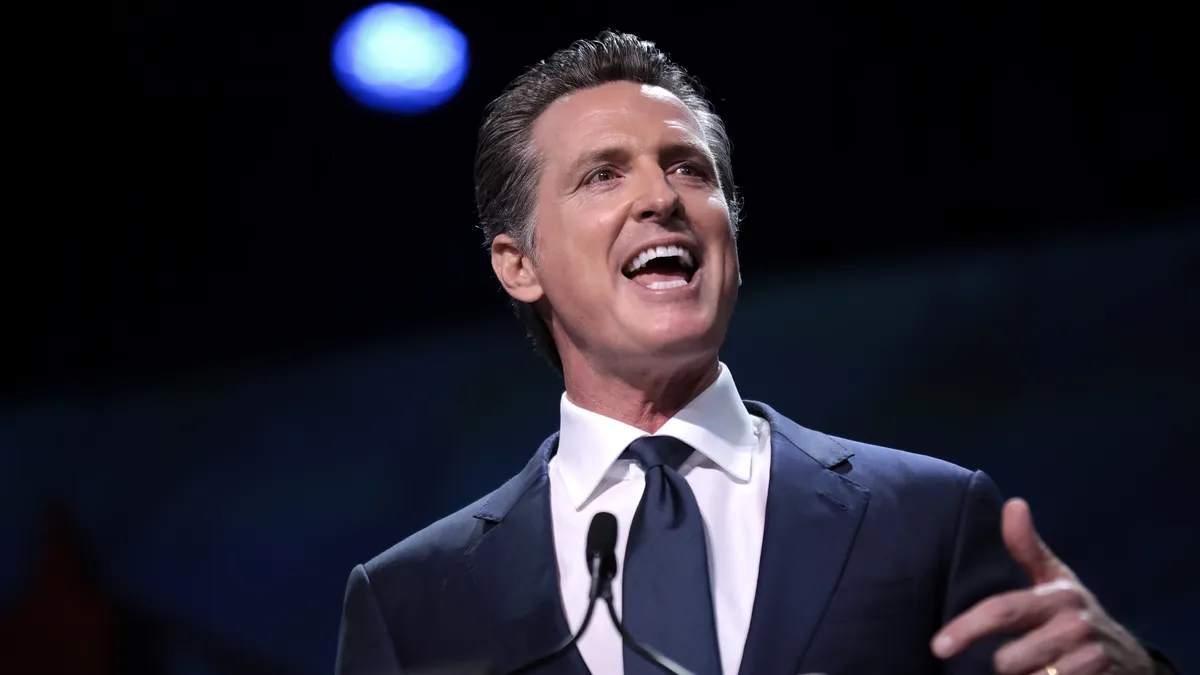Dive Brief:
- California Gov. Gavin Newsom, D, on Friday signed an emergency proclamation to free up energy supply, in a bid to help the state cope with extreme heat events and other reliability challenges.
- The proclamation includes a slew of measures to expedite clean energy projects, particularly battery storage, including streamlining permitting processes. It also includes policies to encourage large energy users to move to back-up power generation during grid emergencies, and pushes regulators to implement plans to offset any resulting increase in emissions.
- Newsom's proclamation is the latest effort from California policymakers to shore up the grid following the rolling blackouts that occurred last August amid a record-breaking heatwave. "We've been able to manage our way through that so far this year, and I think everybody is hopeful that continues to be the case," said Jan Smutny-Jones, CEO of the Independent Energy Producers Association.
Dive Insight:
California energy officials are coping with multiple threats to the grid this summer. Drought conditions have caused the supplies in state reservoirs to dwindle, reducing hydroelectric power capacity by nearly 1,000 MW, while record-breaking heatwaves have been increasing the demand for electricity. In addition, many of the state's transmission lines are located in high fire risk areas, potentially jeopardizing energy supply. The Oregon Bootleg Fire this July, for instance, reduced electricity supply to California by nearly 4,000 MW due to its proximity to the California-Oregon Intertie, a transmission corridor that channels power from the Pacific Northwest into California.
According to the proclamation, California could face a shortfall of up to 3,500 MW this summer during extreme weather events, and a 5,000 MW shortfall next summer, given the likelihood of extended drought, wildfire and heatwaves.
Late last month, Pacific Gas & Electric (PG&E) and San Diego Gas & Electric (SDG&E) both notified regulators of delays to a suite of storage projects that were scheduled to come online on Aug. 1. The projects stemmed from a 2019 California Public Utilities Commission (CPUC) decision, which authorized the procurement of 3.3 GW of clean energy by 2023.
In a July 23 letter, PG&E notified the commission of project development delays, in part due to the COVID-19 pandemic and supply chain disruptions, and said it was informed that not all of the seven storage projects it had proposed to regulators would be online by Aug. 1. SDG&E also wrote a letter to regulators that same day saying it was unlikely that all the lithium-ion storage projects approved by the commission would be online by Aug. 1, and that the utility has urged developers to move aggressively to get the projects online as quickly as possible.
SDG&E and PG&E did not provide details on whether the projects were in fact delayed beyond Aug. 1, citing market sensitive and confidential information.
"Unfortunately, project development issues outside of our control are impacting the schedules of energy projects that we have contracted for with the approval of the CPUC. We have urged the project developers to take aggressive action to bring these projects online as soon as possible," SDG&E said in an emailed statement.
"As with any construction project, there is the potential for conditions that can create delays. The potential has increased due to the COVID-19 pandemic, which has created global supply chain disruptions, shipping delays and construction impacts across varying industries," PG&E spokesperson Paul Doherty said in an emailed statement.
Both utilities pointed to steps they are taking to bolster grid reliability this summer. SDG&E has expanded local energy generation resources and capacity, procured extra reserves and implemented new or expanded demand response programs, the utility said. PG&E is also procuring additional energy supply and beefing up demand response programs, Doherty said, in addition to optimizing its hydroelectric generation to chip in during peak hours on peak demand days.
Newsom's proclamation seeks to address California's reliability challenges this and next summer in part by streamlining permitting processes and other regulations to bring new resources online as quickly as possible this and next year. The proclamation directs the California Energy Commission, and requests the CPUC and California Independent System Operator (CAISO) to work with utilities and other load-serving entities and speed up the construction and procurement of new clean energy and storage projects. It also instructs the state's Department of Finance to pay for utility-created demand response programs, in an attempt to encourage large energy users to conserve electricity during grid emergencies.
In addition, Newsom is asking the CPUC to expedite the approval of expanded demand response programs, as well as storage and clean energy projects, this year and next.
The proclamation's focus on expediting clean energy projects could be helpful, since development often gets tied up in procedural and administrative processes, said Smutny-Jones. At the same time, he is skeptical that the state will be able to bring online more than a limited amount of clean energy this summer.
"Given we are already in August, I don't know how the efforts to remove development hurdles are going to help for this summer," Seth Hilton, partner with Stoel Rives, agreed in an email. The measures could have an impact for the next summer, "but we are still talking about getting a huge amount of additional capacity online in a very short amount of time," he added.















